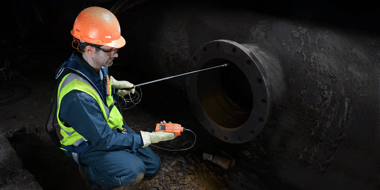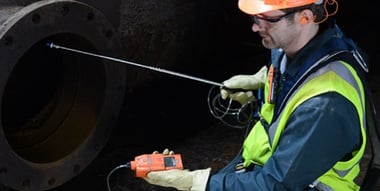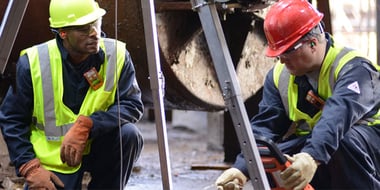A lot can happen in four minutes, especially when those four minutes are spent in a confined space. Confined spaces are prone to oxygen displacement, and after just four minutes without oxygen, you can experience brain damage or even die. It should be no surprise, then, that confined spaces are the leading cause of multiple fatalities in the workplace. That’s why it’s so important to take extra precautions to ensure safety in confined spaces.
It’s an age-old horror story: a worker enters a confined space, most likely for routine maintenance or repair, and an atmospheric hazard is present. When the entrant doesn’t respond to the hole watch, their supervisor and peers get worried, so one of them enters the confined space to check on the original entrant only to be overcome by the same gas hazard. Unfortunately, this scenario is too common—The National Institute for Occupational Safety and Health (NIOSH) reports that 60% of confined space deaths are among these “would-be” rescuers who enter a confined space without understanding the hazards within.
When workers in confined spaces need your help, you can’t act on impulse – you need to be prepared with a plan in place long before the first worker enters a confined space. When creating a confined space entry plan, there are five best practices to keep in mind.
Best Practice 1: Have a Plan
To create a plan, you first need to understand the rules and regulations for confined space entry. Then, create a clear, written procedure your workers can follow.
But you can’t stop there. You must also train your workers on this plan. Eighty five percent of fatalities in confined spaces were among people who hadn't been trained; therefore, it’s crucial that your team is trained and understands how to safely test the atmosphere within a confined space.
Best Practice 2: Know Your Hazards
Knowing the gas hazards that could be present in a confined space is critical for reducing risk. Once you know what gas hazards are likely to be present, you can create a thorough plan for detecting those hazards. You should identify potential hazards before every confined space entry because every space is different.
It's also important to know what hazards may be present so workers can respond safely. All too often, workers ignore alarms because they think it’s a false alarm – this is an extremely risky practice. Knowing the potential gas hazards in advance can help workers take alarms more seriously.
Best Practice 3: Bump Test, Zero, and Calibrate
Once you know your hazards, you can select tools to identify them. An essential tool you need when entering a confined space is a gas detector with the right sensors for your application. But once you select the right sensors, you still need to confirm that your monitor is working properly.
You need to bump test, zero, and calibrate those sensors – skipping even one of these steps puts you at risk of entering a confined space without a gas detector that can alert you to deadly hazards. Bump tests show you whether the sensors can identify gas and whether the alarms and on-screen alerts are working, while calibration shows you whether the gas detector is accurately reading gas concentrations. Zeroing the gas detector in clean, fresh air ensures that you’ve set an accurate baseline for readings.
Best Practice 4: Use a Sampling Pump
While this may seem fundamental, it's so important: the gas detector you are using for pre-entry sampling must be equipped with a sampling pump to draw air from the confined space to the gas detector.
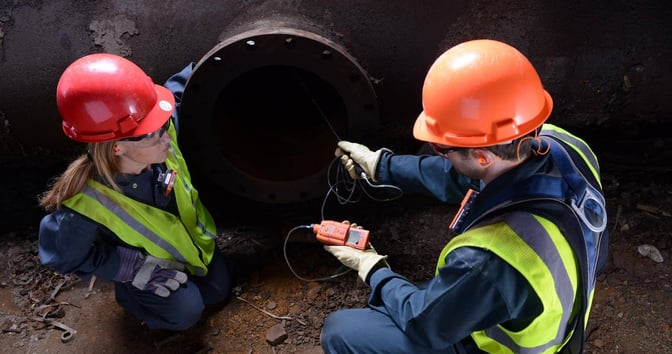 When workers face the pressure of getting a job done quickly, it's easy to cut corners. One common mistake we see is workers putting the gas detector on a rope and dropping it in the confined space, then pulling it out. This will not always detect gas hazards. Instead, it may damage your gas monitor which can harm critical functions and lead to costly repairs.
When workers face the pressure of getting a job done quickly, it's easy to cut corners. One common mistake we see is workers putting the gas detector on a rope and dropping it in the confined space, then pulling it out. This will not always detect gas hazards. Instead, it may damage your gas monitor which can harm critical functions and lead to costly repairs.
You can easily avoid this with a sampling pump. It's also recommended that you follow the 2x2 rule, which is to check levels for two minutes plus two seconds for every foot of tubing. For example, if you are using 20 feet of tubing, you would test for two minutes and 40 seconds to make sure the gas detector has had ample time to read the atmosphere.
Best Practice 5: Continuously Monitor
It's not enough to check for gas hazards in the confined space then throw your monitor back in the truck. Conditions in confined spaces can change rapidly and dramatically, exposing workers to new hazards. Continuously monitoring the confined space is one of the best things you can do to prevent accidents. 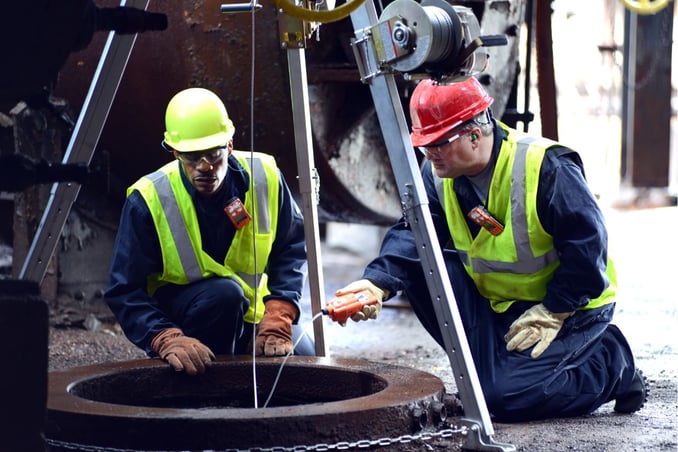 Since many gas hazards are heavier than air, they fill a space from the bottom first. If your entrant is standing in a confined space and it starts to fill with a gas, continuous monitoring with a pumped gas detector can alert both of you to the hazard before it ever reaches the person inside. This allows them to exit the confined space safely.
Since many gas hazards are heavier than air, they fill a space from the bottom first. If your entrant is standing in a confined space and it starts to fill with a gas, continuous monitoring with a pumped gas detector can alert both of you to the hazard before it ever reaches the person inside. This allows them to exit the confined space safely.
But how will others know if a confined space entrant is at risk? Area monitors, like the Radius® BZ1, can help because they provide clear audio and visual alarms so everybody in the area knows there is a gas hazard. You can take this a step further with live monitoring. Live monitoring allows anyone, anywhere, to be alerted when gas hazards put workers in danger so that everyone can respond accordingly.
It's estimated that each week, two workers who enter a confined space won't make it home. Are you doing everything in your power to make sure that doesn't happen to your people? Learn more about safety in confined spaces by watching our webinar, “Best Practices for Monitoring Gas Hazards in Confined Spaces.”
